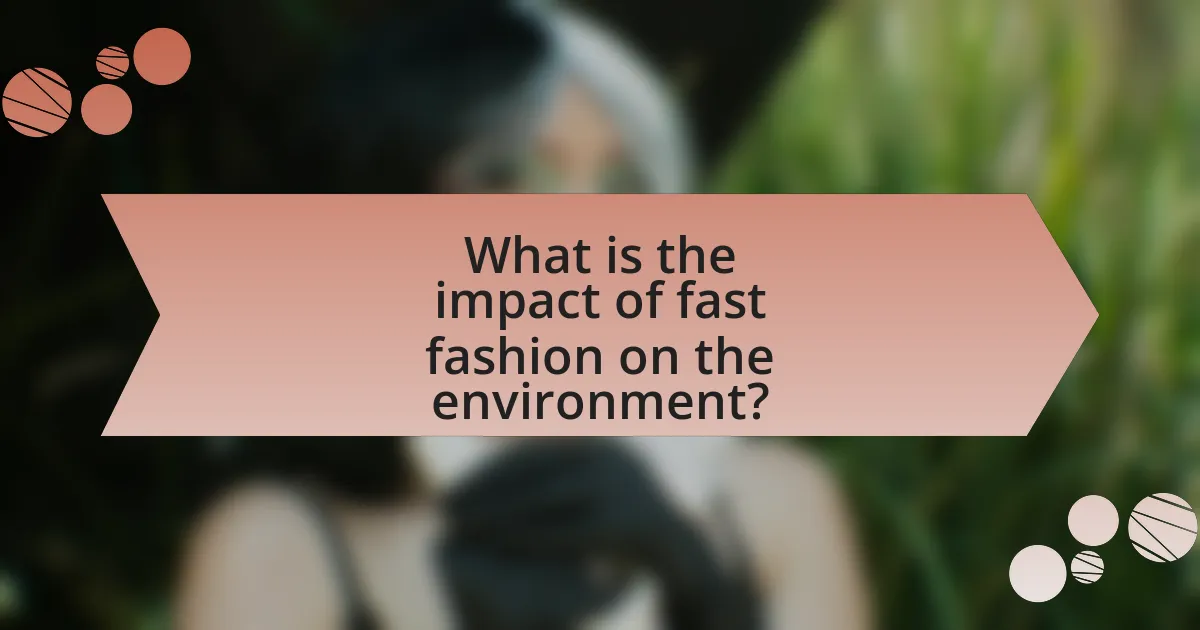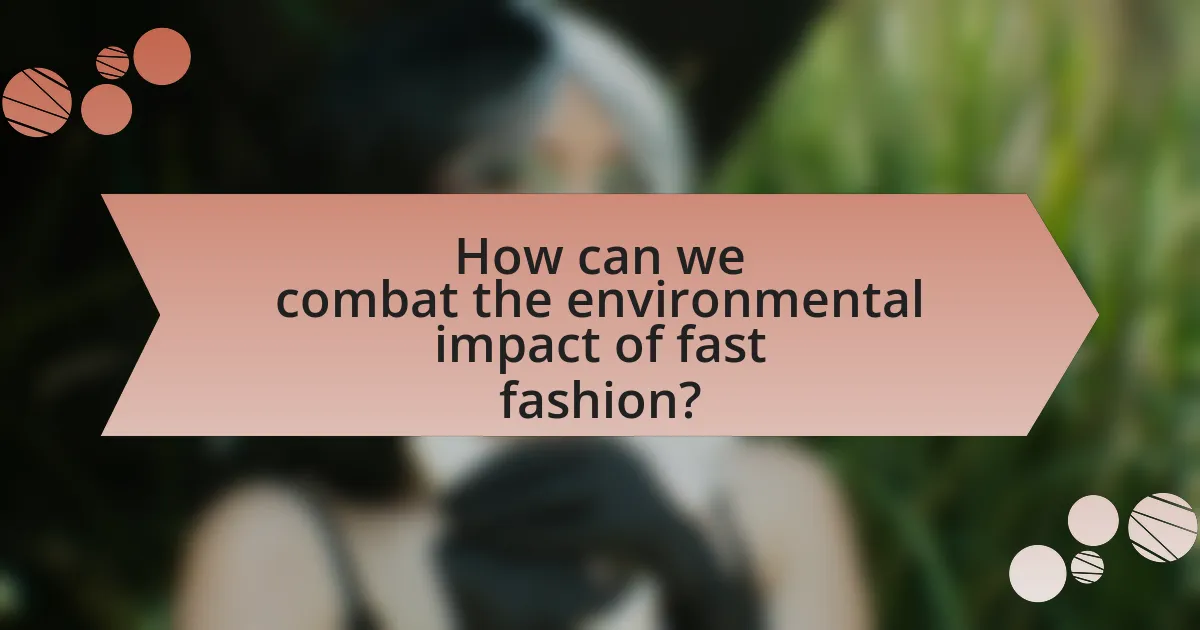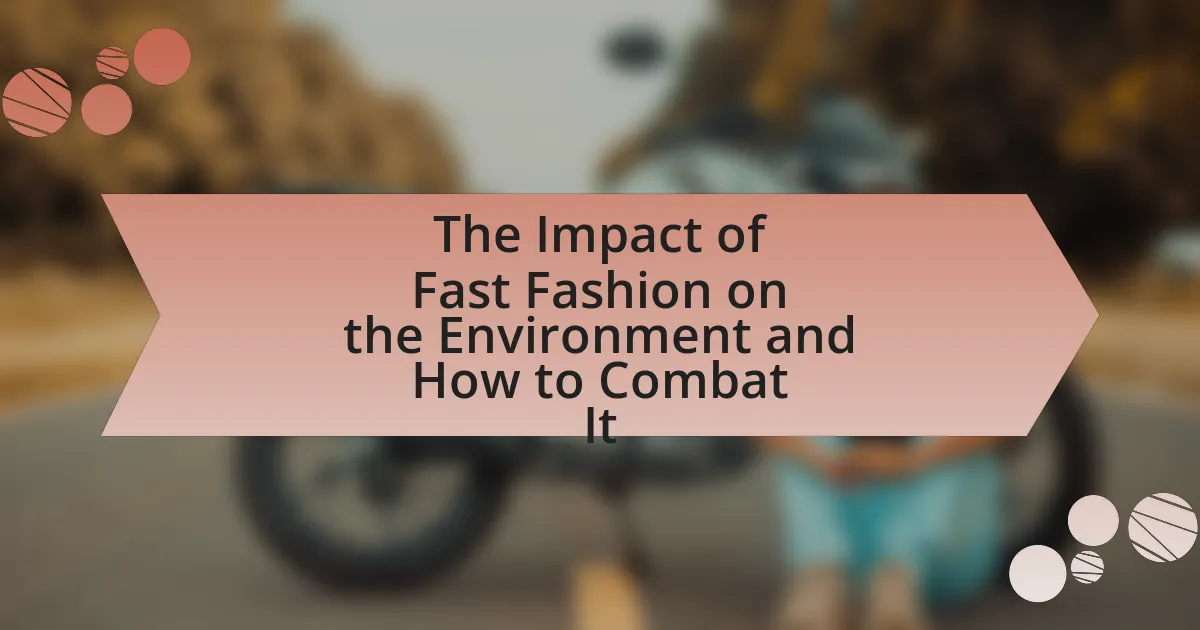The article examines the significant environmental impact of fast fashion, highlighting its contributions to pollution, waste, and resource depletion. It details how the industry generates approximately 92 million tons of textile waste annually, accounts for about 10% of global carbon emissions, and consumes vast amounts of water, exacerbating environmental degradation. The discussion includes the lifecycle of fast fashion garments, the role of consumer behavior in sustainability, and the long-term consequences for ecosystems. Additionally, it explores strategies for combating these issues, such as promoting sustainable practices among consumers and brands, and the importance of education and regulatory measures in fostering a more sustainable fashion industry.

What is the impact of fast fashion on the environment?
Fast fashion significantly harms the environment by contributing to pollution, waste, and resource depletion. The production processes of fast fashion brands often involve toxic chemicals, which contaminate water sources and harm ecosystems. Additionally, the industry is responsible for approximately 10% of global carbon emissions, as reported by the United Nations Environment Programme. Fast fashion also leads to massive textile waste, with an estimated 92 million tons of waste generated annually, much of which ends up in landfills. Furthermore, the rapid production cycles deplete natural resources, including water, with the industry consuming around 79 billion cubic meters of water each year.
How does fast fashion contribute to environmental degradation?
Fast fashion contributes to environmental degradation primarily through excessive resource consumption and waste generation. The industry is responsible for using approximately 93 billion cubic meters of water annually, which is enough to meet the needs of five million people. Additionally, fast fashion produces around 92 million tons of waste each year, with a significant portion ending up in landfills. The rapid production cycles lead to increased carbon emissions, with the fashion industry accounting for about 10% of global carbon emissions. Furthermore, the use of harmful chemicals in textile production contaminates water sources, adversely affecting ecosystems and human health.
What are the primary environmental issues caused by fast fashion?
The primary environmental issues caused by fast fashion include excessive waste generation, water pollution, and high carbon emissions. Fast fashion brands produce millions of garments annually, leading to approximately 92 million tons of textile waste being discarded each year, as reported by the Ellen MacArthur Foundation. Additionally, the dyeing and treatment processes in fast fashion contribute to water pollution, with an estimated 20% of global wastewater coming from the fashion industry. Furthermore, the production and transportation of fast fashion items result in significant carbon emissions, accounting for about 10% of global greenhouse gas emissions, according to the United Nations Environment Programme.
How does fast fashion affect natural resources?
Fast fashion significantly depletes natural resources through excessive water consumption, pollution, and land use. The production of a single cotton t-shirt requires approximately 2,700 liters of water, which is enough for one person to drink for two and a half years. Additionally, the fast fashion industry contributes to water pollution, with textile dyeing processes releasing toxic chemicals into waterways, affecting aquatic ecosystems. Furthermore, the rapid production cycles lead to increased land use for cotton farming and synthetic fiber production, resulting in habitat destruction and biodiversity loss. These practices highlight the detrimental impact of fast fashion on the sustainability of natural resources.
Why is fast fashion considered unsustainable?
Fast fashion is considered unsustainable due to its significant environmental impact, including high resource consumption and waste generation. The production of fast fashion items often requires large amounts of water, with the fashion industry consuming approximately 93 billion cubic meters of water annually, which contributes to water scarcity. Additionally, fast fashion contributes to pollution, as the dyeing and finishing processes release toxic chemicals into waterways. The rapid turnover of clothing leads to massive amounts of textile waste, with an estimated 92 million tons of textiles discarded each year, exacerbating landfill issues. These factors collectively highlight the unsustainable nature of fast fashion.
What role does consumer behavior play in fast fashion sustainability?
Consumer behavior significantly influences fast fashion sustainability by driving demand for inexpensive, trendy clothing. When consumers prioritize low prices and rapid turnover of styles, they contribute to increased production rates, which leads to higher resource consumption and waste generation. According to a 2021 report by the Ellen MacArthur Foundation, the fashion industry is responsible for 10% of global carbon emissions, largely fueled by consumer purchasing habits that favor fast fashion. Additionally, research indicates that if consumers shifted towards more sustainable purchasing practices, such as buying less and choosing higher-quality items, it could reduce the environmental impact of the fashion industry substantially. Thus, consumer choices directly affect the sustainability of fast fashion through their influence on production practices and environmental outcomes.
How does the lifecycle of fast fashion garments impact the environment?
The lifecycle of fast fashion garments significantly impacts the environment through resource depletion, pollution, and waste generation. Fast fashion relies on the rapid production of low-cost clothing, which often involves the use of non-renewable resources such as petroleum for synthetic fibers and large quantities of water for cotton cultivation. For instance, producing a single cotton t-shirt requires approximately 2,700 liters of water, contributing to water scarcity in many regions.
Additionally, the manufacturing process emits greenhouse gases and toxic chemicals, leading to air and water pollution. The World Bank estimates that the fashion industry is responsible for 10% of global carbon emissions. Once garments are discarded, they often end up in landfills, where they can take decades to decompose, releasing methane, a potent greenhouse gas. In fact, the Ellen MacArthur Foundation reports that a truckload of textiles is landfilled or incinerated every second.
Overall, the lifecycle of fast fashion garments creates a cycle of environmental degradation, from resource extraction to waste disposal, highlighting the urgent need for sustainable practices in the fashion industry.
What are the long-term consequences of fast fashion on ecosystems?
The long-term consequences of fast fashion on ecosystems include significant biodiversity loss, soil degradation, and water pollution. Fast fashion contributes to habitat destruction as land is cleared for cotton farming and textile production, leading to a decline in species diversity. Additionally, the use of harmful chemicals in dyeing processes contaminates water sources, affecting aquatic life and human health. According to the United Nations Environment Programme, the fashion industry is responsible for 20% of global wastewater, highlighting its detrimental impact on ecosystems. Furthermore, the fast fashion model promotes overconsumption, resulting in increased textile waste that often ends up in landfills, where it can take decades to decompose, further harming the environment.
How does fast fashion contribute to pollution and waste?
Fast fashion contributes to pollution and waste primarily through the rapid production and disposal of low-cost clothing. The industry is responsible for approximately 10% of global carbon emissions, largely due to the energy-intensive processes involved in manufacturing and transporting garments. Additionally, fast fashion generates significant textile waste; around 92 million tons of textiles are discarded annually, with much ending up in landfills. The use of synthetic fibers, which take hundreds of years to decompose, exacerbates this issue, as they release microplastics into the environment during washing. Furthermore, the chemical dyes and treatments used in fast fashion production contaminate water sources, harming aquatic ecosystems.
What effects does fast fashion have on biodiversity?
Fast fashion significantly harms biodiversity by contributing to habitat destruction, pollution, and overexploitation of resources. The rapid production cycles and high demand for cheap clothing lead to deforestation, particularly in regions like the Amazon, where land is cleared for cotton farming. Additionally, the use of synthetic fibers, such as polyester, results in microplastic pollution in oceans, adversely affecting marine life. A study published in the journal “Nature” indicates that textile production is responsible for 20% of global wastewater, which further degrades ecosystems. Furthermore, the fast fashion industry often relies on unsustainable practices that deplete natural resources, threatening various species and disrupting ecological balance.

How can we combat the environmental impact of fast fashion?
To combat the environmental impact of fast fashion, consumers can adopt sustainable practices such as buying second-hand clothing, supporting ethical brands, and reducing overall consumption. Research indicates that the fashion industry is responsible for 10% of global carbon emissions and significant water pollution, highlighting the urgent need for change. By choosing to purchase from brands that prioritize sustainability and transparency, individuals can help reduce the demand for fast fashion, which often relies on exploitative labor practices and environmentally harmful production methods. Additionally, promoting clothing recycling and upcycling can further mitigate waste, as the average person discards around 81 pounds of clothing each year.
What strategies can consumers adopt to reduce fast fashion consumption?
Consumers can adopt several strategies to reduce fast fashion consumption, including prioritizing sustainable brands, buying second-hand clothing, and practicing mindful shopping. By choosing sustainable brands, consumers support companies that prioritize ethical production and environmentally friendly practices. Purchasing second-hand clothing extends the lifecycle of garments and reduces demand for new production, which is a significant contributor to environmental degradation. Mindful shopping involves assessing needs before making purchases, avoiding impulse buys, and focusing on quality over quantity, which can lead to a more sustainable wardrobe. These strategies collectively contribute to a decrease in fast fashion consumption and its associated environmental impacts.
How can sustainable fashion choices be promoted among consumers?
Sustainable fashion choices can be promoted among consumers through education, transparency, and community engagement. Educating consumers about the environmental impact of fast fashion, such as the fact that the fashion industry contributes to 10% of global carbon emissions, can raise awareness and encourage more responsible purchasing decisions. Transparency in supply chains allows consumers to understand the origins of their clothing, fostering trust and accountability. Additionally, community engagement initiatives, such as clothing swaps and local sustainable fashion events, can create a sense of belonging and motivate consumers to adopt sustainable practices. These strategies collectively empower consumers to make informed choices that support sustainable fashion.
What role does education play in combating fast fashion?
Education plays a crucial role in combating fast fashion by raising awareness about its environmental and social impacts. Through educational initiatives, individuals learn about the consequences of overconsumption, such as increased waste and pollution, which are significant issues associated with fast fashion. For instance, studies show that the fashion industry is responsible for 10% of global carbon emissions and is a major contributor to water pollution. By integrating sustainability into curricula, educational programs empower consumers to make informed choices, promoting ethical purchasing behaviors and encouraging support for sustainable brands. This knowledge can lead to a reduction in demand for fast fashion, ultimately contributing to a more sustainable industry.
What initiatives are brands taking to address fast fashion’s impact?
Brands are implementing various initiatives to address the impact of fast fashion, including sustainable sourcing, recycling programs, and transparency in supply chains. For instance, companies like H&M and Zara have introduced garment collection schemes that encourage customers to recycle old clothing, thereby reducing waste. Additionally, brands are increasingly committing to using organic or recycled materials; for example, Adidas has partnered with Parley for the Oceans to create shoes made from ocean plastic. Furthermore, many brands are enhancing transparency by publishing detailed reports on their supply chains, which helps consumers make informed choices. These initiatives collectively aim to mitigate the environmental damage associated with fast fashion, as evidenced by a growing trend towards circular fashion and sustainable practices in the industry.
How are companies implementing sustainable practices in production?
Companies are implementing sustainable practices in production by adopting eco-friendly materials, optimizing resource efficiency, and reducing waste. For instance, many fashion brands are now using organic cotton, recycled polyester, and biodegradable fabrics to minimize environmental impact. Additionally, companies are investing in technologies that enhance energy efficiency in manufacturing processes, such as using renewable energy sources and implementing water-saving techniques. According to a report by the Ellen MacArthur Foundation, transitioning to a circular economy in fashion could reduce greenhouse gas emissions by 44% by 2030, demonstrating the effectiveness of these sustainable practices.
What certifications or standards exist for sustainable fashion brands?
Certifications and standards for sustainable fashion brands include Global Organic Textile Standard (GOTS), OEKO-TEX Standard 100, Fair Trade Certified, and the Responsible Wool Standard (RWS). GOTS ensures organic status of textiles, including environmental and social criteria, while OEKO-TEX Standard 100 certifies that textiles are free from harmful substances. Fair Trade Certified focuses on fair labor practices and sustainable livelihoods for workers, and RWS promotes responsible animal welfare and land management practices in wool production. These certifications provide a framework for brands to demonstrate their commitment to sustainability and ethical practices in the fashion industry.
What policies can governments implement to mitigate fast fashion’s effects?
Governments can implement policies such as imposing stricter regulations on textile waste management and promoting sustainable production practices to mitigate fast fashion’s effects. Stricter regulations can include mandatory recycling programs and penalties for excessive waste, which encourage brands to adopt circular economy principles. Additionally, governments can provide incentives for companies that utilize sustainable materials and ethical labor practices, thereby reducing the environmental impact associated with fast fashion. For instance, the European Union’s Circular Economy Action Plan aims to make sustainable products the norm, which directly addresses the issues caused by fast fashion.
How can regulations encourage sustainable practices in the fashion industry?
Regulations can encourage sustainable practices in the fashion industry by mandating environmentally friendly production processes and promoting transparency in supply chains. For instance, regulations that require brands to disclose their sourcing and manufacturing practices can lead to increased accountability and consumer awareness, driving companies to adopt sustainable methods. The European Union’s Circular Economy Action Plan, which aims to make sustainable products the norm, exemplifies how regulatory frameworks can incentivize brands to reduce waste and improve resource efficiency. Additionally, implementing stricter standards for waste management and chemical use can compel manufacturers to innovate and invest in sustainable technologies, ultimately reducing the industry’s environmental footprint.
What role do international agreements play in combating fast fashion?
International agreements play a crucial role in combating fast fashion by establishing binding commitments among countries to promote sustainable practices in the textile industry. These agreements, such as the Paris Agreement, aim to reduce carbon emissions and encourage responsible consumption and production patterns. For instance, the United Nations Framework Convention on Climate Change emphasizes the need for countries to collaborate on strategies that mitigate environmental impacts, which directly influences the fast fashion sector by pushing for regulations that limit waste and pollution. Additionally, international trade agreements can include provisions that incentivize sustainable sourcing and ethical labor practices, thereby holding brands accountable for their environmental footprint.

What are the future trends in sustainable fashion?
Future trends in sustainable fashion include the increased use of circular economy principles, innovative materials, and technology-driven solutions. Circular economy practices focus on designing products for longevity, repairability, and recyclability, reducing waste significantly. For instance, brands like Stella McCartney are pioneering the use of biodegradable materials and closed-loop systems, which allow for the recycling of garments into new products. Additionally, advancements in technology, such as 3D printing and digital fashion, are enabling brands to minimize resource consumption and waste. According to a report by McKinsey & Company, the sustainable fashion market is projected to grow significantly, driven by consumer demand for transparency and ethical practices.
How is technology influencing sustainable fashion practices?
Technology is significantly influencing sustainable fashion practices by enabling more efficient production processes, reducing waste, and promoting transparency in supply chains. Innovations such as 3D printing allow designers to create garments with minimal material waste, while digital platforms facilitate the sharing of resources and second-hand clothing, thereby extending the lifecycle of fashion items. Additionally, technologies like blockchain enhance traceability, allowing consumers to verify the sustainability claims of brands. According to a report by McKinsey & Company, the adoption of digital technologies in fashion can reduce greenhouse gas emissions by up to 30% by 2030, highlighting the potential of technology to drive sustainability in the industry.
What innovations are emerging in sustainable materials and production methods?
Innovations in sustainable materials and production methods include the development of bio-based textiles, such as those made from organic cotton, hemp, and recycled plastics, which significantly reduce environmental impact. For instance, companies are increasingly utilizing fabrics derived from recycled PET bottles, which can save up to 60% in energy consumption compared to virgin polyester production. Additionally, advancements in dyeing technologies, such as waterless dyeing processes and natural dyes, minimize water usage and chemical waste. Research indicates that these methods can reduce water consumption by up to 90% compared to traditional dyeing techniques. Furthermore, 3D printing is emerging as a method to create garments on demand, which reduces waste associated with overproduction. These innovations collectively contribute to a more sustainable fashion industry by addressing the environmental challenges posed by fast fashion.
How can digital platforms promote sustainable fashion choices?
Digital platforms can promote sustainable fashion choices by providing consumers with access to information about eco-friendly brands, sustainable practices, and the environmental impact of their purchases. For instance, platforms like Instagram and Pinterest allow brands to showcase their sustainable collections and educate consumers on the benefits of choosing sustainable materials. Research indicates that 66% of consumers are willing to pay more for sustainable brands, highlighting the demand for transparency and ethical practices in fashion. Additionally, digital platforms can facilitate second-hand shopping through resale apps, reducing waste and extending the lifecycle of clothing.
What consumer trends are shaping the future of fashion sustainability?
Consumer trends shaping the future of fashion sustainability include increased demand for transparency, a preference for eco-friendly materials, and a rise in second-hand shopping. Consumers are increasingly seeking brands that disclose their supply chain practices, with 73% of millennials willing to pay more for sustainable products, according to a 2019 Nielsen report. Additionally, the popularity of sustainable materials, such as organic cotton and recycled fabrics, is growing, as evidenced by a 2021 McKinsey report indicating that 67% of consumers consider sustainability when making fashion purchases. The second-hand market is also expanding, with ThredUp reporting a 27% increase in resale shopping in 2021, highlighting a shift towards circular fashion practices.
How is the demand for transparency affecting fashion brands?
The demand for transparency is significantly affecting fashion brands by compelling them to disclose their supply chain practices and sustainability efforts. As consumers increasingly prioritize ethical consumption, brands are pressured to provide clear information about sourcing, labor conditions, and environmental impact. For instance, a 2021 survey by McKinsey & Company found that 67% of consumers consider transparency important when making purchasing decisions, leading brands like Patagonia and Everlane to adopt more open policies regarding their production processes. This shift not only enhances brand loyalty but also drives innovation in sustainable practices, as companies strive to meet consumer expectations for accountability and ethical standards.
What impact does the rise of second-hand and rental fashion have on sustainability?
The rise of second-hand and rental fashion significantly enhances sustainability by reducing waste and lowering the demand for new clothing production. This shift helps to mitigate the environmental impact associated with fast fashion, which is responsible for approximately 10% of global carbon emissions and substantial water usage. By promoting the reuse of garments, second-hand and rental markets extend the lifecycle of clothing, thereby decreasing the volume of textile waste that ends up in landfills. Additionally, studies indicate that purchasing second-hand clothing can reduce carbon footprints by up to 73% compared to buying new items. This trend not only fosters a more sustainable fashion ecosystem but also encourages consumers to adopt more environmentally conscious behaviors.
What practical steps can individuals take to support sustainable fashion?
Individuals can support sustainable fashion by choosing to buy from brands that prioritize ethical production and environmentally friendly materials. This includes researching companies that use organic fabrics, fair labor practices, and sustainable manufacturing processes. According to a 2021 report by the Ellen MacArthur Foundation, the fashion industry is responsible for 10% of global carbon emissions, highlighting the importance of conscious consumer choices. Additionally, individuals can reduce their fashion footprint by purchasing second-hand clothing, participating in clothing swaps, and properly recycling or donating garments they no longer wear. These actions contribute to reducing waste and promoting a circular economy in fashion.
How can consumers make informed choices when shopping for clothing?
Consumers can make informed choices when shopping for clothing by researching brands’ sustainability practices and understanding the environmental impact of their purchases. This involves examining labels for materials used, seeking certifications like Fair Trade or Global Organic Textile Standard, and prioritizing brands that promote ethical labor practices. Studies indicate that the fashion industry is responsible for 10% of global carbon emissions, highlighting the importance of conscious consumerism. By choosing sustainable options, consumers can significantly reduce their ecological footprint and support environmentally responsible practices.
What are some effective ways to reduce clothing waste in daily life?
To reduce clothing waste in daily life, individuals can adopt practices such as buying second-hand clothing, engaging in clothing swaps, and choosing high-quality, durable garments. Buying second-hand clothing extends the life cycle of garments and reduces demand for new production, which is responsible for significant environmental impact. Clothing swaps allow individuals to refresh their wardrobe without purchasing new items, effectively minimizing waste. Additionally, opting for high-quality clothing reduces the frequency of replacements, as these items tend to last longer, thereby decreasing overall consumption. According to the Ellen MacArthur Foundation, the fashion industry is responsible for 92 million tons of waste annually, highlighting the importance of these practices in combating clothing waste.
